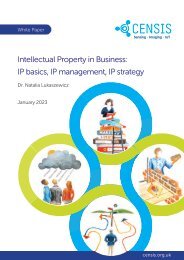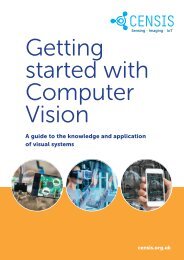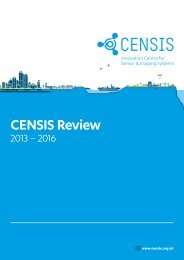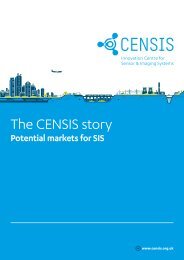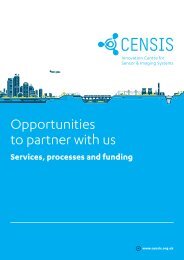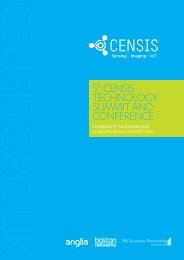Getting started with IoT
IoT is here and it's time for organisations across the country to take advantage of the transformational benefits of the technologies and expertise available. CENSIS explores IoT for business growth in this IoT starter guide. censis.org.uk
IoT is here and it's time for organisations across the country to take advantage of the transformational benefits of the technologies and expertise available. CENSIS explores IoT for business growth in this IoT starter guide. censis.org.uk
Create successful ePaper yourself
Turn your PDF publications into a flip-book with our unique Google optimized e-Paper software.
Emerging business models<br />
Data optimisation<br />
In this model, businesses deploy devices to their customers,<br />
generally at low/no cost to the user, to gather additional<br />
data around another service they provide. The data gathered<br />
is valuable to both the user and the company and can help<br />
companies retain users by understanding how their product<br />
is used. It can also help the company drive more efficiency in<br />
their business.<br />
Examples: Smart meters <strong>with</strong> home readout units for the<br />
customers. Customers understand their energy usage and<br />
utility providers benefit from better data about usage patterns<br />
to create efficiencies in supply and customer relations.<br />
(customer value service).<br />
Charge per usage<br />
With <strong>IoT</strong>, a business receives detailed device usage patterns<br />
data. This model allows a business to supply a service in a<br />
customer’s facility but the customer is charged on a pay per<br />
use model; only paying for the time they use the device.<br />
The customer does not buy the product, but the output<br />
from the use of the product, and will pay a variable amount<br />
depending on usage pattern. This model can be used to<br />
reduce the capital costs of equipment by purchasing the<br />
service on an operational basis.<br />
Examples: In aviation it is common for the jet engine to be<br />
paid for based on the amount of time the engine spends<br />
in flight. The engine manufacturer owns the engine and is<br />
responsible for maintenance to ensure the engine spends as<br />
much time as possible in use.<br />
Efficiency of operation<br />
This is based around a company deploying <strong>IoT</strong> applications<br />
that will result in efficiency savings <strong>with</strong>in a customer’s<br />
current business. The company deploying the service will<br />
generally provide it at no cost to the customer but take their<br />
revenue from any reduction in the price of the service.<br />
This benefits the customer as they would generally pay<br />
less than they currently pay and it also generates additional<br />
information from the <strong>IoT</strong> data.<br />
Examples: There are examples of this type of model in the<br />
smart city and facility management space where a company<br />
will use <strong>IoT</strong> to make a service more efficient and agree to a<br />
form of reduction in current costs, <strong>with</strong> the company keeping<br />
the savings generated.<br />
Asset sharing<br />
One of the enduring problems <strong>with</strong> sharing of assets is<br />
understanding the time each asset is used by each user<br />
so they can be charged based on time used. It differs from<br />
the product usage model as lots of different people utilise<br />
the asset.<br />
Examples: In the transportation sector, bike and car-sharing<br />
programmes run on this basis.<br />
12





